Understanding Final Resting Places: What You Need to Know
When saying goodbye to a loved one who has chosen cremation, there's more to consider than you might initially think. Cremation urns and vaults play different but equally important roles in creating a dignified final resting place.
Many families are familiar with urns but are surprised when they learn about vault requirements at the cemetery. Let me walk you through what you need to know in simple, straightforward terms.
An urn is the container that holds your loved one's ashes, while a vault is the protective outer container that surrounds the urn when it's buried. Think of it like this – the urn is the treasure chest holding precious memories, and the vault is the safe that protects that chest from the elements.
| Item | Purpose | Required? | Average Cost |
|---|---|---|---|
| Cremation Urn | Holds cremated remains | Always needed for cremation | $50-$300 |
| Urn Vault | Protects the urn from ground pressure and moisture | Required by most cemeteries for ground burial | $45-$1,000 |
Why do cemeteries require vaults? It's actually quite practical. Without a sturdy vault, even the most durable urns can eventually succumb to soil pressure, moisture, and the weight of maintenance equipment passing overhead. This leads to sunken graves – depressions in the earth that can be both unsightly and costly to repair.
"If you don't like the idea of a sunken grave and disturbed ashes, you should purchase a vault." — Funeral industry recommendation
The good news is that there are options for every budget. If cost is a concern, polymer (plastic) urn vaults are accepted by most cemeteries and offer excellent protection at a lower price point than concrete or metal alternatives. These lightweight options are easier to handle at the graveside too.
Standard adult urns typically hold 200-220 cubic inches of cremated remains. Urn vaults are designed with enough interior space to comfortably fit these urns plus any small mementos or keepsakes you might wish to include alongside your loved one.
Here at American Mortuary Coolers, we've worked with funeral professionals nationwide to help them select appropriate cremation urns and vaults that balance protection, appearance, and budget. Our experience as a national supplier of mortuary equipment has given us valuable insight into creating dignified final arrangements that bring peace of mind to families.
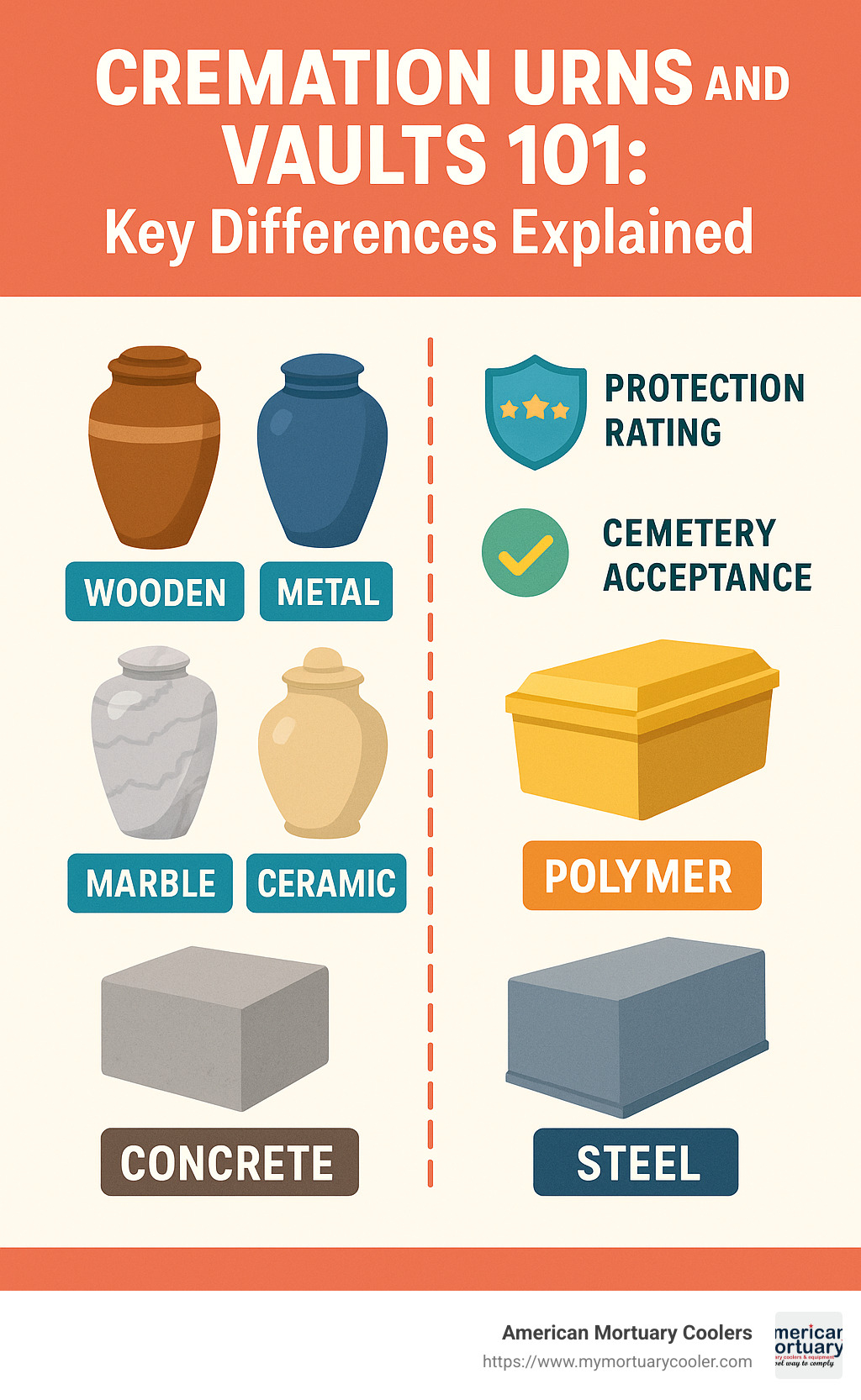
Important cremation urns and vaults terms you might encounter:
What Is a Cremation Urn?
When someone you love passes away and chooses cremation, their ashes need a special home. That's exactly what a cremation urn provides – a dignified container designed specifically to hold cremated remains with care and respect.
Think of an urn as the final home for your loved one's ashes. These special containers come in countless designs that can reflect personality, passions, and the unique life they lived. From traditional vase shapes to artistic sculptures, wooden boxes, and even eco-friendly options, there's truly an urn for every person and preference.
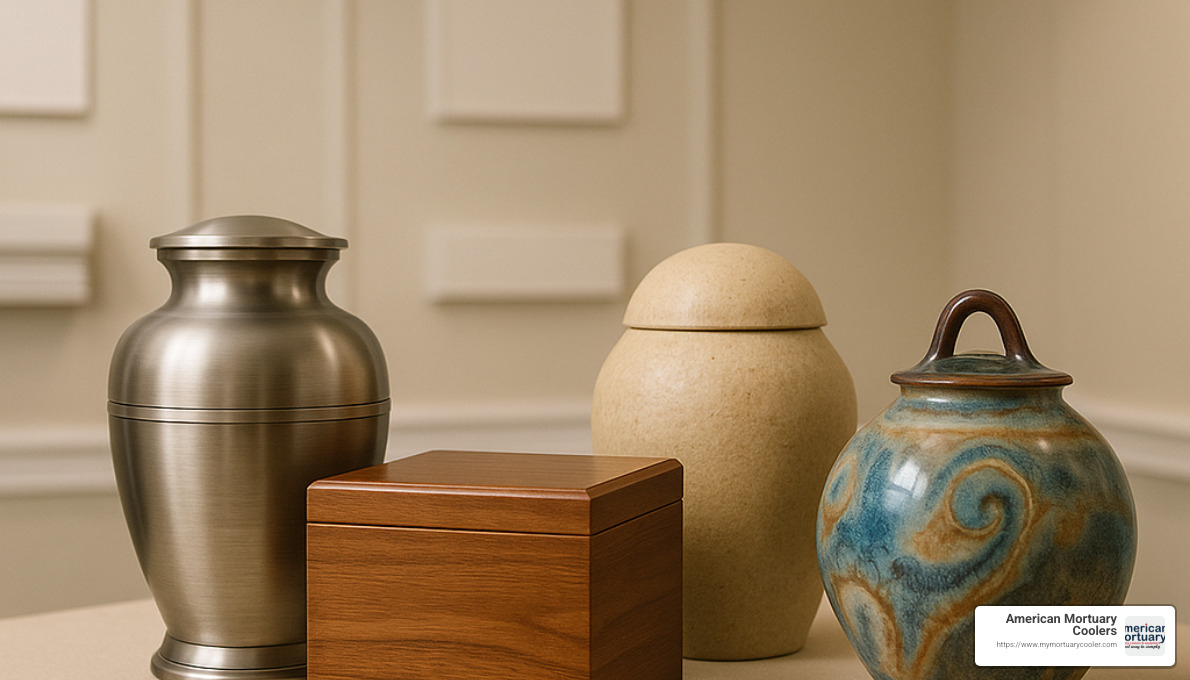
Urns serve different purposes depending on your plans. Display urns are crafted with beautiful details since they'll be kept at home or placed in a columbarium where they can be visited and seen. Burial urns focus more on durability and protection since they'll be placed in the ground.
"Families often select urns that reflect the personality or interests of their loved one. We've seen everything from hand-carved wooden vessels to custom-painted ceramics that tell a story." — Funeral Director, Southeast Region
Not sure where to start? You're not alone. Many families feel overwhelmed when choosing an urn, which is why we've created a comprehensive resource to help. More info about cremation urn selection
Standard Adult Urns: Sizes & Capacities
When it comes to sizing, there's a simple guideline most funeral professionals follow: the 200 cubic inch rule. This standard size accommodates the cremated remains of adults weighing up to about 200 pounds, based on the principle that cremation typically produces about one cubic inch of remains per pound of body weight.
Most standard adult urns provide 200-220 cubic inches of space. For larger individuals, oversized urns are readily available. For couples who wish to remain together even after death, companion urns offer double capacity (usually around 400 cubic inches) and come in two styles: those with a single chamber that combines the ashes, and those with dual compartments to keep remains separate but together.
Families who wish to share remains often choose mini keepsake urns – smaller versions (typically 1-50 cubic inches) that allow multiple relatives to each keep a portion of their loved one close. These often match the design of the main urn, creating a beautiful connection between family members who may live far apart.
Materials & Styles Explained
The material of an urn affects not just how it looks, but also its durability, weight, and whether it will need additional protection if buried. Here's what you should know about the most common options:
Bronze and metal urns offer exceptional durability and often showcase intricate designs. These heavyweight options can withstand the test of time and resist environmental damage, making them suitable for both display in your home and burial in a cemetery.
Cultured marble urns blend crushed natural stone with refined resins to create a solid, substantial container. Many are compression-tested and approved for direct burial without requiring a separate vault – a practical two-in-one solution that can save families money and simplify decisions.
Hardwood urns bring natural warmth and elegance to memorialization. Crafted from beautiful woods like walnut, oak, maple or cherry, these urns offer a traditional look that many families find comforting. While gorgeous, they may require a vault for cemetery burial since wood naturally deteriorates over time.
Biodegradable urns address growing environmental concerns by naturally breaking down when buried or placed in water. Made from materials like paper, salt, or plant-based compounds, these support green burial practices for those who wish their final act to benefit the earth.
Many families find comfort in selecting decorative sculpture urns that celebrate their loved one's passions – from military themes for veterans to nature-inspired designs for outdoor enthusiasts, religious symbols for the faithful, or hobby representations for those with special interests. These personalized touches help keep memories alive in meaningful ways.
No matter which type of urn feels right for your situation, cremation urns and vaults work together to provide both dignity and protection for your loved one's final resting place.
What Is a Cremation Urn Vault?
A cremation urn vault is essentially a protective outer shell that cradles a cremation urn when buried in the ground. Think of it as a mini-casket designed specifically for an urn—providing both structural support and a shield against the elements that might otherwise damage the urn and its precious contents.
The main reasons families choose urn vaults are straightforward and practical:
- They prevent that sad, sunken appearance that happens when graves settle over time
- They shield the urn from being crushed by soil weight and heavy lawn equipment
- They create a moisture barrier that preserves both the urn and the cremated remains inside
While cremation urns and vaults serve different purposes, they work together as a complete burial system. Urns are often crafted with aesthetics in mind—beautiful wood, ceramic, or metal designs that honor your loved one. Vaults, on the other hand, focus on strength and protection, using materials built for durability:
Polymer and ABS plastic vaults have become increasingly popular because they're lightweight, affordable, and accepted by most cemeteries. Many families appreciate not having to deal with the extreme weight of traditional options.
Concrete vaults offer traditional, heavy-duty protection and are often reinforced with special interior liners for added durability. They've been the cemetery standard for generations.
Steel or metal vaults provide premium protection with excellent resistance to corrosion, though they typically come at a higher price point.
Fiberglass options give you lightweight durability with outstanding moisture resistance, making them a modern alternative worth considering.
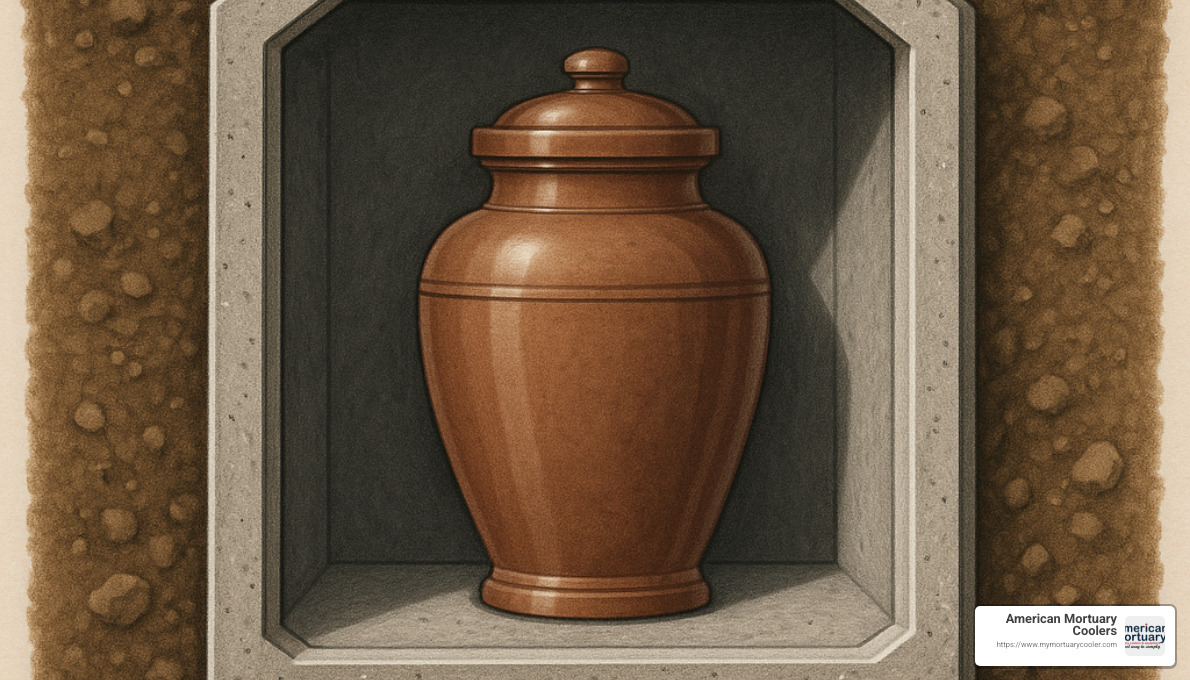
Most urn vaults feature a simple but effective two-piece design—a base that holds the urn and a lid that fits securely on top. These two pieces are typically sealed together during the burial ceremony. Premium models often include extra features like rubber gaskets, tongue-and-groove sealing systems, or specialized interior linings that provide improved protection.
National Funeral Directors Association resource
How Urn Vaults Protect Ashes
An urn vault works in several important ways to safeguard your loved one's remains:
The moisture barrier is perhaps the most critical function. Quality vaults with polymer liners or sealed designs keep groundwater from reaching the urn and its contents. This protection is especially important if you've chosen a wooden or biodegradable urn, which would quickly break down when exposed to moisture.
The vault's structure also provides weight distribution, spreading the pressure of soil and maintenance equipment across its surface rather than directly onto the urn. Many premium vaults feature clever "down and out" cover designs that channel pressure toward the vault's edges, maintaining the integrity of the seal.
Perhaps most visibly, vaults provide ground stabilization by maintaining their shape over time, preventing the soil above from sinking. This helps keep the cemetery looking well-maintained and dignified, while reducing ongoing maintenance costs.
Thomas Jordan, Director at Gate of Heaven in Cincinnati, shares his real-world experience: "Our move to the Crowne Urn Vault has proved to be a great decision, both operationally and for the benefit of the families that we serve. The various size options provide versatility in any condition, the style is sleek and neat, and the durability and light weight is vastly superior to the outdated concrete options."
The level of protection you receive varies by vault type. Basic vaults provide fundamental structural support with minimal moisture resistance. Improved vaults add better sealing systems and moderate moisture barriers. Ultimate protection vaults incorporate high-grade polymer liners, reinforced concrete, and sophisticated sealing systems for maximum peace of mind.
Are Urn Vaults Required?
Whether you'll need an urn vault depends primarily on cemetery policies rather than legal requirements. Most cemeteries do require some type of outer burial container for cremation urns, though specific requirements can vary widely:
Most public and private cemeteries require a vault for ground burial simply because it prevents maintenance headaches down the road. State and local regulations generally don't mandate vaults by law, but they do allow cemeteries to set their own policies. Religious cemeteries might have specific requirements based on their traditions and practices.
These requirements stem from practical considerations. Cemeteries need level grounds for both appearance and safety—it's much easier to maintain cemetery grounds when they don't have to steer around sunken areas, and it's safer for visitors who won't trip on uneven ground.
It's worth noting that if you're keeping an urn at home, placing it in a columbarium niche, or scattering the ashes, no vault is needed. The vault requirement applies specifically to in-ground burial.
Miranda Jones shared her family's experience after her mother-in-law passed: "The cemetery provided a Crowne Vault for the burial. We appreciated the details being taken care of and having a simple option for her cremains. Having something to protect the urn in the ground was important to us, and there was room for her favorite nightgown and reading glasses."
The best approach is always to have a conversation with your funeral director or cemetery administrator early in the planning process. They can explain the specific requirements for your chosen burial location and help you understand what options will work best for your situation and budget.
Cremation Urns and Vaults: Key Differences & When You Need Both
When planning final arrangements, understanding the difference between cremation urns and vaults can save you time, money, and potential headaches. These two items work together but serve completely different purposes in the memorial process.
| Feature | Cremation Urn | Urn Vault |
|---|---|---|
| Primary Purpose | Hold cremated remains | Protect the urn from environmental factors |
| Required For | All cremations | Ground burial in most cemeteries |
| Typical Materials | Metal, wood, ceramic, glass, marble | Polymer, concrete, steel, fiberglass |
| Aesthetic Focus | High (often decorative) | Medium to Low (functional) |
| Average Cost Range | $50-$300 | $45-$1,000 |
| Customization Options | Extensive | Limited to moderate |
| Weight | 1-10 pounds | 12-100+ pounds |
Think of it this way: the urn is like a beautiful picture frame that holds something precious, while the vault is the protective glass and backing that keeps it safe from damage. Both have their place in preserving memories.
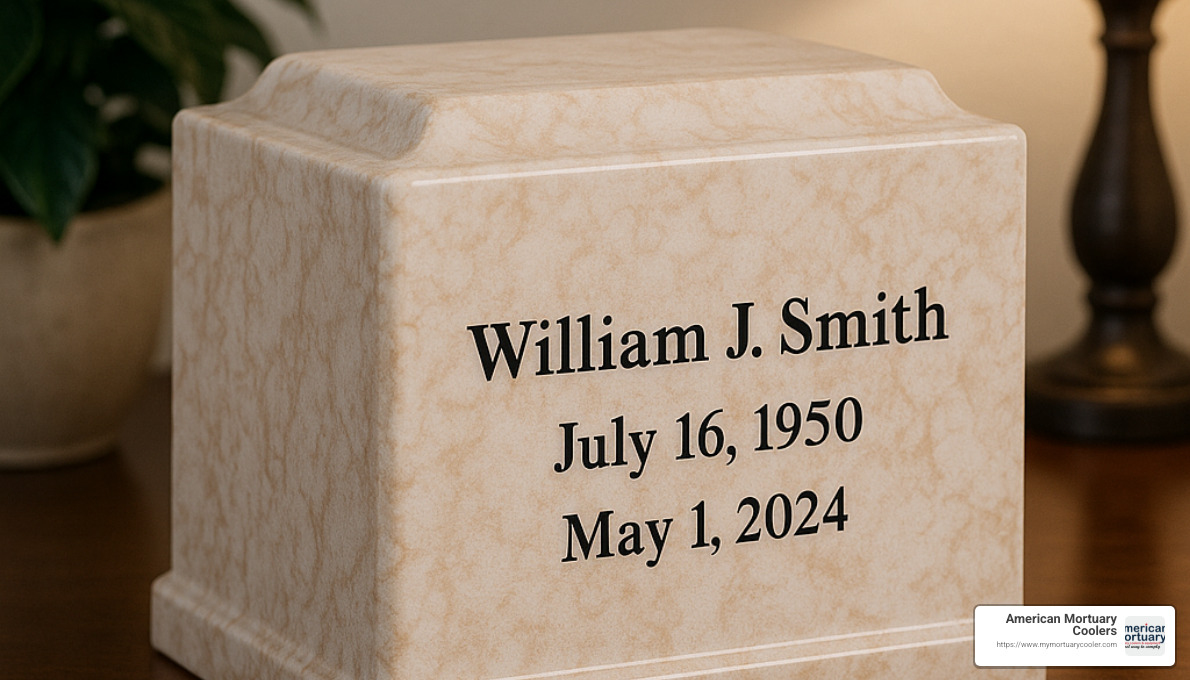
Choosing Between Cremation Urns and Vaults
Making the right choice about cremation urns and vaults doesn't have to be overwhelming. Your decision really boils down to a few key factors.
First, consider your final disposition plans. If you're keeping the urn at home on the mantel or placing it in a columbarium niche, you'll only need a beautiful urn. For cemetery burial, you'll typically need both an urn and a vault (or a combination unit that serves both purposes). If you're planning to scatter the ashes, you might only need a temporary urn until the ceremony.
Budget matters too. Standard burial usually involves purchasing separate urn and vault pieces. If you're looking to save money, combination urn/vault units offer great value. For those seeking premium protection, lined and sealed vaults paired with decorative urns provide the highest level of care.
Material durability is another consideration. Those lovely biodegradable urns need vaults if cemetery burial is planned. Cultured marble urns sometimes qualify as self-contained vaults (a two-for-one deal). Delicate ceramic or glass urns always need protective vaults for burial – they simply won't hold up to the pressure of soil and maintenance equipment.
"I always recommend families call the cemetery before making any purchases," shares one of our funeral director partners in Pittsburgh. "I've seen too many situations where families bought beautiful urns only to find they didn't meet cemetery requirements. A five-minute phone call can save a lot of heartache."
More info about vault durability
Combination Units: All-in-One Cremation Urns and Vaults
For those who appreciate simplicity (and saving money), combination urn/vault units offer the perfect solution. These clever products do double-duty as both the container for remains and the protective burial container.
Cultured marble combinations are particularly popular. These durable units feature an inner chamber for remains and an outer shell strong enough to withstand ground pressure. Many come in dozens of colors – we've seen everything from emerald green to rose pink – and can be personalized with beautiful engraving. The Mackenzie Cultured Marble Urn Vault is one we often recommend for its blend of elegance and practicality.
Polymer combinations like the Regal and Tribute series offer lighter-weight alternatives with attractive finishes such as White Silver and Pebble Dust. Typically holding around 211-217 cubic inches of remains and weighing only about 12 pounds, they're much easier to handle than concrete options (your back will thank you).
For couples planning to rest together, companion models provide space for two sets of remains. The Crowne Vault Double and Marquis Double Urn Vault maintain all the protection benefits while accommodating two people's ashes – together forever, as many couples wish to be.
What makes these combination units special is their verified strength. They've been compression-tested to withstand the weight of earth and even heavy cemetery equipment, giving families peace of mind that their loved one's remains will stay protected for generations to come.
Materials, Sizes, and Protection Levels
When it comes to cremation urns and vaults, the materials used and design features directly impact how well they'll protect your loved one's remains. Understanding these differences helps you choose the right option for your specific needs and budget.
Polymer and ABS plastic vaults have become increasingly popular due to their lightweight nature and affordability. Most cemeteries now accept these modern materials, which typically range from $45-$180. While they may not have the same premium look as other options, they provide excellent protection for most situations.
"We've seen a significant shift toward polymer vaults over the past decade," shares one of our funeral directors. "Families appreciate that they're much easier to handle than concrete while still meeting cemetery requirements."
Concrete vaults remain the traditional choice, offering exceptional durability but at the cost of being extremely heavy and difficult to transport. These typically run between $250-$500. For those seeking something in between, fiberglass vaults ($150-$300) offer excellent moisture resistance without excessive weight.
Premium options include bronze-lined vaults ($500-$1,000+) and stainless steel models ($300-$600), which provide superior protection and a high-end appearance for those with larger budgets.
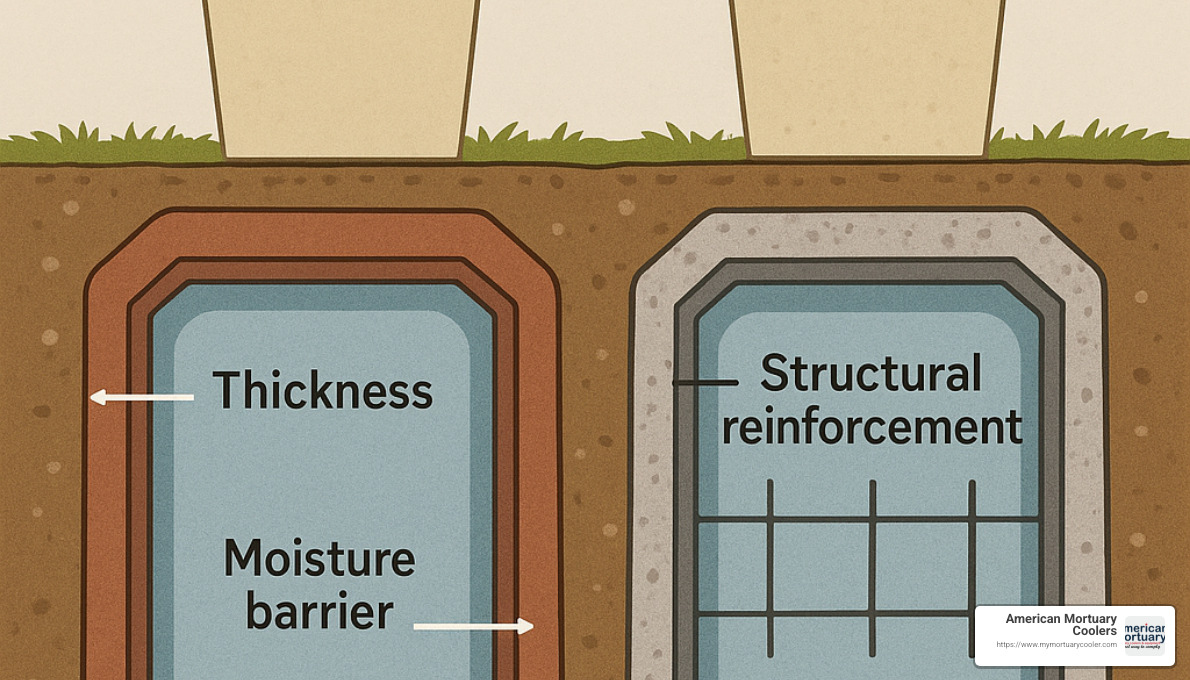
Most standard urn vaults measure approximately 15"L × 15"W × 18"H, though you'll find variations to meet different needs. Low-profile models (typically 15"L × 15"W × 14"H) are perfect for cemeteries with height restrictions, while double or companion vaults are wider to accommodate two urns side by side.
More info about biodegradable urns
Matching Urn Dimensions to Vault Interior
One of the most heartbreaking mistakes we see in funeral planning is finding at the graveside that an urn won't fit into its vault. To avoid this stressful situation, always measure your urn's exterior dimensions completely—height, width, and depth—including any decorative elements that stick out.
Compare these measurements to the vault's interior dimensions, allowing at least half an inch of clearance on all sides. The Universal Urn Vault, for example, offers interior dimensions of 9.75"H × 9.75"W × 12.74"L, while the Crowne Vault features a more spacious interior at 14"W × 12"H × 10"D with a 14.5" dome.
Many families want to include small keepsakes, photographs, or letters alongside the urn. If you're planning to do this, make sure to select a vault with extra space. As one customer shared with us, "Being able to include Mom's favorite brooch and a family photo meant everything to us. I'm so glad we chose a vault with enough room."
Protection Tiers Explained
Not all urn vaults offer the same level of protection. They typically fall into three categories:
Basic protection vaults like the Economy Urn Vault feature single-layer construction (usually polymer) with a simple sealing mechanism. They provide fundamental structural support at the lowest price point.
Standard protection options include the Regent and Crowne Vaults, which offer improved sealing systems (often with adhesive tape or butyl sealer) and moderate moisture barriers. These mid-range options strike a nice balance between protection and affordability.
Premium protection vaults such as the Aegean Ultra or Stainless Steel Triune feature multi-layer construction with reinforced concrete, high-grade polymer liners, and advanced sealing systems. These top-tier options provide superior moisture and weight resistance for those seeking the ultimate protection.
When evaluating different protection levels, pay attention to the lid design—"down and out" covers distribute weight to the perimeter rather than directly onto the urn. Also look at the sealing mechanism (corner bolts or wide adhesive edges indicate better seals) and the liner material (vacuum-formed polymer liners provide superior moisture protection).
At American Mortuary Coolers, we've helped funeral homes across the country select appropriate cremation urns and vaults that balance protection, aesthetics, and budget considerations. We understand that these choices are deeply personal and reflect how you wish to honor your loved one's memory.
Costs, Customization, and Popular Brands
When it comes to cremation urns and vaults, prices can vary quite a bit – from budget-friendly options to premium customized memorials. Most families are surprised to find the wide range of choices available to honor their loved ones.
Price Ranges
You'll find cremation urns and vaults at price points that work for nearly any budget. Basic urns start around $50-$100, while more decorative options typically range from $100-$300. For those seeking something truly special, premium artistic urns can reach $800 or more.
The vault side follows a similar pattern. Simple polymer vaults (which most cemeteries accept) run about $45-$180, standard protection models land in the $180-$400 range, and premium lined vaults with advanced sealing systems can cost between $400-$1,000+.
If you're looking to simplify, combination urn/vaults offer good value. Cultured marble combinations typically cost $195-$400, while premium combinations with personalization might run $400-$600.
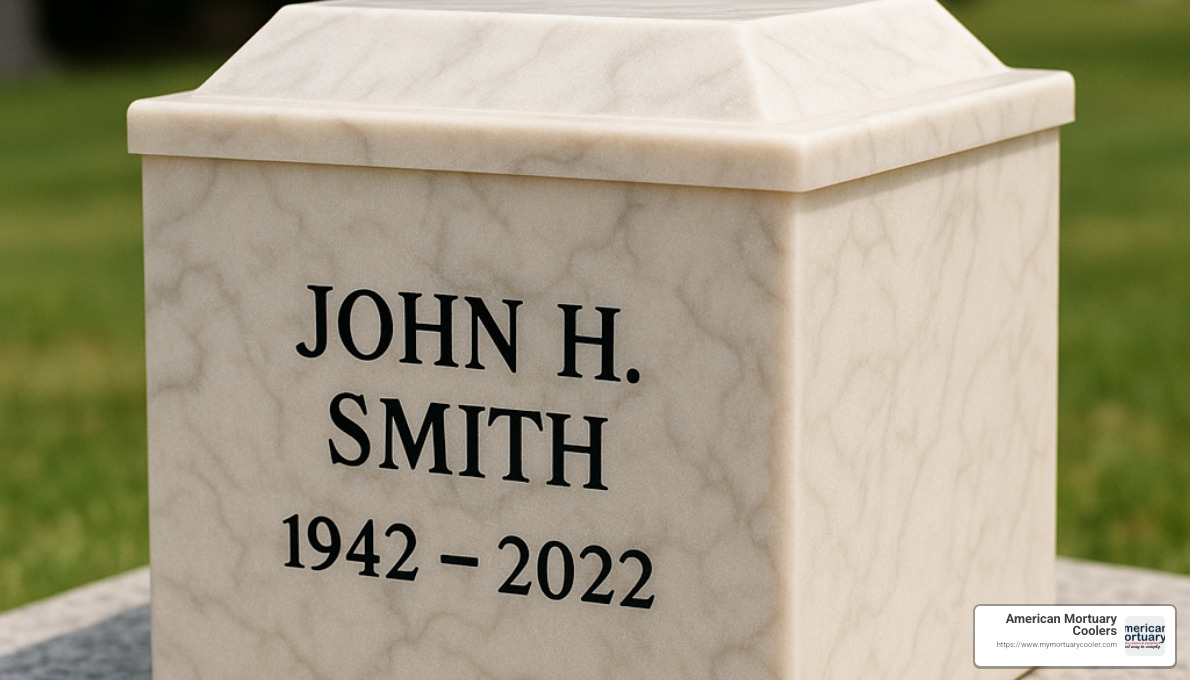
Popular Brands and Models
Several manufacturers have built solid reputations in the cremation urns and vaults industry. Trigard stands out with their multi-layered protection systems and "down and out" cover design that cleverly distributes soil weight to the perimeter for a better seal. As Greg Tilley, a funeral professional we work with, often says: "Trigard is simply the best at what they do!! Their passion for customer service and continually striving to overachieve is second to none!"
Crowne Vault offers lightweight polymer options that never corrode or deteriorate – a major advantage over traditional concrete. Their Regent Knight Black model uses recycled polymer, which appeals to environmentally conscious families.
Doric produces the popular Chelsea and Hannah tall urn vaults with reliable protection at reasonable prices, while Mackenzie specializes in cultured marble combination urn/vaults that come in over 40 colors with extensive personalization options.
Custom Urns: Creating a Unique Tribute
Budgeting for Burial: What Drives Price?
When helping families plan, we always recommend looking beyond just the price tag of the cremation urns and vaults themselves. Several factors influence the total cost of the burial.
Material quality makes a big difference – bronze-lined or stainless steel vaults naturally cost more than basic polymer models. The level of protection also impacts price, with multi-layered systems commanding premium prices.
Don't forget about cemetery fees, which can sometimes surprise families. These typically include plot purchase (if not previously owned), opening and closing the grave ($200-$500), weekend or holiday surcharges, and perpetual care fees.
Transportation costs matter too, especially for heavier concrete vaults. That's why many funeral directors appreciate the lightweight polymer options we supply – they're easier to handle and less expensive to ship.
Personalization adds to the base price but creates a more meaningful memorial. And here's a money-saving tip: combination urn/vaults often cost less than purchasing separate components.
Personalization Options
Today's cremation urns and vaults offer wonderful ways to create truly personal memorials. Laser engraving is probably the most popular option, allowing names, dates, meaningful quotes, poems, or religious verses to be permanently added to many materials. Cultured marble units take engraving particularly well, creating beautiful results.
Color selection has come a long way too. The Mackenzie line features over 40 color options, letting families choose something that resonates with their loved one's personality or preferences.
Military families appreciate options for service branch emblems, flag displays, and patriotic designs. And for those who want something truly unique, some manufacturers like Trigard offer photo appliqués that add personal images to vault covers.
"The personalization made all the difference," one family told us after adding their mother's favorite roses to her vault cover design. "It felt like the memorial truly reflected who she was."
Some manufacturers even offer interactive ceremonies, such as Trigard's Healing Tree service, which includes a touching poem reading and Memory Ring keepsakes for family members – adding a meaningful ritual to the burial process.
At American Mortuary Coolers, we've helped funeral directors across the country select the right cremation urns and vaults for their families' needs. We understand that these choices matter deeply, and we're committed to providing options that honor each unique life with dignity and care.
Step-by-Step Burial & Transportation Guide
Planning the final journey for cremated remains involves several important steps that families and funeral directors should understand. Whether you're arranging a burial locally or transporting ashes across the country, knowing what to expect makes the process smoother during an already difficult time.
Before the Burial
Before the day of the service, several preparations need to be made. Start by verifying the cemetery's specific requirements for cremation urns and vaults. Each cemetery has its own rules about acceptable vault materials, size restrictions, and personalization options.
Obtaining the necessary permits is a crucial step that can't be overlooked. Burial permits must be filed with the cemetery sexton, the county where burial will take place, and in some cases, state authorities. Requirements vary by location, so check local regulations early in the planning process.
Don't forget to notify the cemetery sexton well before the inurnment date. The sexton will mark the exact grave opening location and confirm any fees associated with opening and closing the grave. Be aware that weekend or holiday services often incur additional charges.
"The most common mistake I see families make is not confirming all the cemetery requirements until the last minute," explains one of our funeral directors. "It's much easier to plan ahead than to scramble for alternatives on the day of the service."
Equipment preparation is another essential step. Order the urn vault well in advance, arrange for a lowering device if needed, and request a tent and chairs for the committal service if desired. Many families appreciate having shade and seating, particularly for elderly attendees.

During the Burial Service
The day of the service involves several important steps to ensure a dignified burial. First comes vault preparation – placing the urn inside the vault base and adding any small keepsakes or mementos the family wishes to include. Many families include photographs, small jewelry items, or handwritten notes. Next, apply the sealant (typically butyl sealer or adhesive tape) to the vault rim.
When sealing the vault, position the cover carefully on the base and press firmly to engage the seal. Some models have corner bolts that need to be tightened securely. This creates the protective barrier that will shield the cremation urns and vaults from environmental elements for years to come.
The lowering ceremony is often the most emotional moment. A small lowering device may be used, or the vault can be lowered by hand. Many funeral directors encourage family participation if desired – this hands-on involvement can be a meaningful part of saying goodbye. Some families incorporate special rituals like the Healing Tree ceremony, where family members receive keepsake tokens.
After the formal service concludes and attendees depart, cemetery staff will complete the burial process by filling the grave and restoring the ground surface. This final step is typically not witnessed by the family.
After the Service
Once the service ends, several follow-up steps occur. The cemetery staff handles grave filling and ground restoration, placing a temporary marker if the permanent one isn't yet installed. They'll also manage initial ground settling maintenance.
Permanent marker installation typically happens after the ground has settled, usually 3-6 months after burial. You'll want to coordinate with the cemetery for precise timing and verify any restrictions regarding marker size or style. Some cemeteries have strict regulations about monument dimensions and materials.
More on funeral communication logistics
Committal Service Checklist
For funeral directors and cemetery staff, having a comprehensive checklist helps ensure all details are managed properly. This includes filing the burial permit, notifying the sexton, delivering the vault, preparing sealant materials, setting up equipment, arranging seating, confirming timing with the officiant, paying fees, arranging transportation, verifying personalization details, and establishing a weather contingency plan.
These details might seem overwhelming during a time of grief, which is why working with experienced professionals can ease the burden on families. At American Mortuary Coolers, we work closely with funeral homes to ensure they have the resources needed to guide families through these processes with compassion and attention to detail.
Traveling with Ashes & Urns
When families need to transport cremated remains for burial in distant locations, special considerations apply, especially for air travel. Understanding these requirements in advance prevents unnecessary stress during transit.
Documentation is essential when traveling with cremation urns and vaults. Always carry a copy of the death certificate, the cremation certificate from the crematory, and for air travel, a TSA declaration form. Keep these documents easily accessible throughout your journey.
The container you choose matters significantly for smooth travel. Consider using a non-metallic or lightweight metal urn that allows for easier x-ray screening. Many families opt for temporary plastic or cardboard containers specifically for transport, transferring to a permanent urn at their destination. Always pack urns securely in carry-on luggage – never check cremated remains with baggage.
If flying, inform the airline in advance about transporting cremated remains. Arrive at the airport early to allow time for additional screening, and be prepared for respectful hand-inspection of the container. As one family member shared after flying with cremated remains: "The TSA agents were incredibly respectful. I told them what was in the container, they did a quick test with a paper strip, and we were on our way. Much easier than I expected."
International transport requires additional research. Look into the destination country's specific requirements, obtain consular approval if necessary, and translate documentation if traveling to non-English speaking countries. Some nations have strict regulations about importing human remains, even in cremated form.
With proper planning and understanding of these procedures, the journey of your loved one to their final resting place can be handled with dignity and care, regardless of distance.
Environmental Impact & Long-Term Care
As families become more environmentally conscious, many are taking a closer look at how their memorial choices affect our planet. Cremation urns and vaults come with varying ecological footprints, and understanding these impacts can help you make choices that align with your values while still honoring your loved one.
Let's face it – traditional burial practices weren't designed with environmental concerns in mind. But today, we have options that balance protection, dignity, and sustainability.
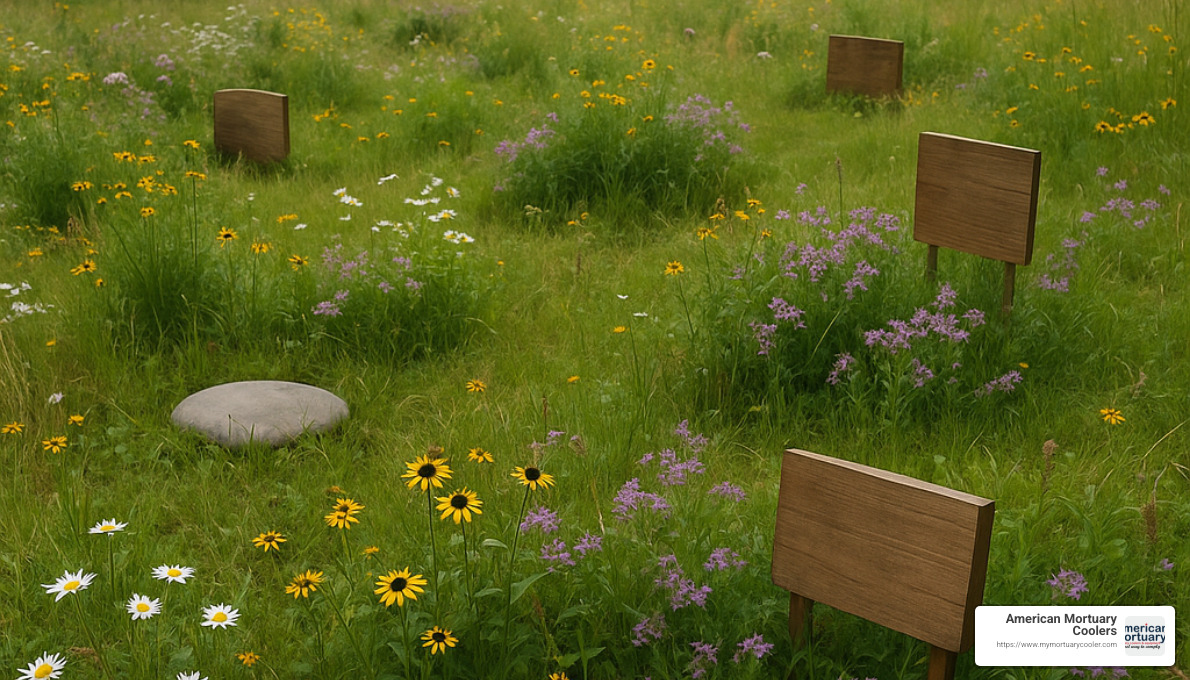
When it comes to vault materials, each has its environmental trade-offs. Polymer vaults are lightweight, reducing transportation emissions and some newer models use recycled materials – though they remain non-biodegradable. The Regent Knight Black recycled polymer vault is a step in the right direction, supporting a zero-waste lifecycle while still meeting cemetery requirements.
Concrete vaults offer durability but come with a significant carbon footprint from cement production. Their weight also means higher transport emissions. Metal vaults use recyclable materials but require energy-intensive mining and manufacturing processes.
For those seeking to minimize environmental impact, combination urn/vaults use fewer materials overall and are typically lighter than separate components, though they may still contain non-biodegradable elements.
"We're seeing more families ask about the environmental impact of their choices," shares one of our funeral director partners. "It's not just about the immediate need anymore – people want to know their final arrangements reflect the values they lived by."
Green Burial Alternatives
If traditional cemetery burial doesn't align with your environmental values, several greener alternatives to standard cremation urns and vaults exist.
Biodegradable urns made from recycled paper, salt compounds, or plant-based materials naturally break down when buried, returning remains to the earth. While beautiful and meaningful, these may not be accepted for traditional cemetery burial without a protective vault.
Many families find comfort in tree urns, which contain a tree seed or sapling alongside biodegradable materials. As the tree grows, it creates a living memorial nourished in part by the cremated remains. These are typically planted in natural burial grounds or on private property where allowed by local regulations.
For those drawn to water, water-soluble urns dissolve when placed in water, facilitating sea scattering ceremonies in an neat way. Made from salt, sand, or other naturally dissolving materials, they offer a beautiful transition for those who loved the ocean.
Conservation burial in specialized natural burial grounds eliminates the need for vaults entirely. These grounds often use burial fees to support land conservation efforts, creating a meaningful environmental legacy alongside a natural return to the earth.
Many cemeteries now offer scattering gardens – dedicated sections where remains can be scattered without containers. These areas typically feature communal memorialization options and eliminate the need for both urns and vaults.
A family who chose a conservation burial shared with us: "Knowing Dad's remains would help preserve the woodland he loved brought us real comfort. It felt right that his final act would protect the nature he cherished throughout his life."
Maintaining Gravesite Integrity
For those who choose traditional burial with cremation urns and vaults, some ongoing attention ensures the gravesite remains a dignified memorial for generations.
Regular visits offer opportunities to check for any signs of settling or sinking – though with a properly installed vault, these issues should be minimal. While there, take a moment to clear away leaves or debris and tend to any plantings if the cemetery allows them.
Marker maintenance is important regardless of burial method. Clean stone or bronze markers according to material guidelines (avoid harsh chemicals on stone), check for stability, and address any inscription fading. Many cemeteries have staff who can recommend proper cleaning techniques that won't damage the marker.
Be mindful of seasonal considerations too. Remove holiday decorations promptly when they become weathered, and understand your cemetery's rules about what decorations are permitted and when. Some have strict policies about what can be placed at gravesites and when items must be removed.
Keeping open communication with cemetery staff ensures any concerns can be addressed quickly. Understand what perpetual care services are included with your plot purchase, and keep your contact information updated with the cemetery office.
"The whole point of requiring vaults is to prevent future maintenance issues," explains one cemetery director we work with. "A quality vault installation should provide decades of stability with minimal intervention – that's why we recommend them even when they're not strictly required."
At American Mortuary Coolers, we believe in balancing tradition with innovation. While our primary focus is providing quality mortuary equipment, we understand the complete journey families take when making memorial decisions. Whether you choose traditional methods or more ecological alternatives, what matters most is creating a meaningful tribute that honors both your loved one and the values they held dear.
Frequently Asked Questions about Cremation Urns and Vaults
What size urn vault do I need for an adult?
Finding the right size vault for your loved one's urn is one of the most common questions we hear. Most adult urn vaults measure about 15"L × 15"W × 18"H, though you'll also find low-profile options at 15"L × 15"W × 14"H for cemeteries that restrict height.
The key thing to remember isn't just the outer dimensions, but making sure the interior space fits your chosen urn comfortably. You'll want at least half an inch of clearance on all sides. For example, the Universal Urn Vault offers interior dimensions of 9.75"H × 9.75"W × 12.74"L, while the Crowne Vault gives you more room at 14"W × 12"H × 10"D.
I always recommend measuring your urn's exterior dimensions first, then comparing them to the vault's interior capacity. This simple step prevents the heartache of finding at the cemetery that your urn doesn't fit the vault you've purchased.
Are urn vaults legally required everywhere?
Here's a surprise for many families: there's actually no state or federal law requiring cremation urns and vaults in the United States. The requirements you'll encounter come from individual cemetery policies, not government regulations.
Cemeteries create these rules for practical reasons - they need to maintain level grounds, prevent sinking graves, and ensure their equipment can safely move across the property. Different cemeteries have different policies based on:
Their type (public, private, religious, or green burial grounds) Local soil conditions and water table levels What kind of maintenance equipment they use Their historical practices and traditions
Before making any purchases, I always suggest calling your chosen cemetery directly to ask about their specific requirements. This simple call can save you both money and stress during an already difficult time.
Can one urn vault hold two sets of ashes?
Yes, you absolutely can keep loved ones together in the afterlife. When families ask me about this, I share these three main options:
Double or companion vaults are specifically designed with larger dimensions to hold two standard urns side by side. The Marquis Double Urn Vault or Crowne Vault Double (with generous interior dimensions of 14"W × 12"H × 10"D) are perfect examples.
Another approach is using a standard vault with a companion urn - a single larger urn that contains both sets of remains. This works beautifully when cemetery space is limited.
Some families opt for an oversized single vault that can accommodate two standard urns positioned carefully inside. You'll need to check the specific interior dimensions to ensure this works.
The most important question to discuss as a family is whether you want the ashes commingled in one container or kept separate in individual urns within a larger vault. There's no right answer - it's entirely about what feels most meaningful to your family.
How can I tell how sturdy an urn vault might be?
When families invest in cremation urns and vaults, they want assurance that their loved one's remains will be protected for generations. To evaluate a vault's durability, I recommend examining several key features:
Look at the material composition first - reinforced concrete with polymer liners generally offers more protection than single-material vaults. The connection between lid and base matters too; wide adhesive edges, tongue-and-groove designs, or corner bolts create tighter seals against moisture.
Pay attention to the top load pressure rating, as higher ratings indicate better resistance to soil weight and maintenance equipment. Water resistance features like specialized gaskets, butyl sealers, or waterproof liners make a significant difference in wet climates.
Wall thickness is another good indicator - thicker walls provide greater structural integrity. Premium options like Trigard models feature "the thickest cover in the industry" along with vacuum-formed polymer liners and reinforced concrete for truly comprehensive protection.
What questions should I ask my funeral director about urn vaults?
Having guided many families through this process, I find the conversation with your funeral director goes more smoothly when you come prepared with questions. When discussing cremation urns and vaults, consider asking:
"What are the specific vault requirements at my chosen cemetery?" This is the most important starting point, as requirements vary widely.
"Can you explain the different protection levels and their prices?" Understanding what you're paying for helps make an informed decision.
"Are combination urn/vault options available?" These can be more cost-effective than purchasing separate pieces.
"What personalization is possible?" Many families find comfort in customizing the vault with engravings or emblems.
I also suggest asking practical questions about the sealing process, warranty coverage, whether family members can participate in the placement, and all associated cemetery fees. Getting these answers upfront prevents surprises later.
Finally, don't hesitate to ask if small mementos can be placed inside the vault alongside the urn. Many families find comfort in including special items like photos, letters, or small keepsakes in this final resting place.
Conclusion
Cremation urns and vaults play different but equally important roles when it comes to honoring your loved ones. While urns cradle the cremated remains with dignity, vaults provide that crucial layer of protection needed for cemetery burial—keeping the ground from settling, blocking out moisture, and making sure the burial site stays intact for generations to come.
The decisions you make about these items blend practical needs with deeply personal choices. Every selection—from the materials you choose to the personalization touches you add—helps create a meaningful tribute that truly reflects the person being remembered.
Here at American Mortuary Coolers, we've seen how important these choices are to families. Our team works with funeral professionals across the country, from the rolling hills of Johnson City, Tennessee to the busy streets of Los Angeles, California. We're dedicated to sharing our knowledge and offering quality products that help funeral directors guide families through difficult decisions with both sensitivity and expertise.
There's a perfect combination of urn and vault out there for every need. You might be looking for something simple and budget-friendly, or perhaps a premium memorial with custom engraving—either way, understanding the options available helps you make choices you can feel good about during a challenging time.
The right cremation urns and vaults provide more than just practical function—they offer peace of mind. Knowing that your loved one's remains are protected and their memorial will stand the test of time brings comfort during the grieving process.
For funeral professionals reading this, we invite you to explore our full range of mortuary equipment and supplies. Our team is always ready to answer questions and provide personalized recommendations based on your specific needs and the families you serve.
The choices we make about final arrangements reflect both our love for those we've lost and our desire to create lasting tributes to their lives. We're honored to be part of that important process.



















